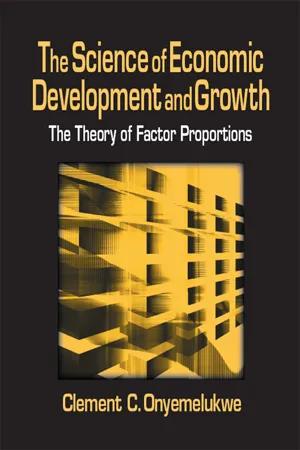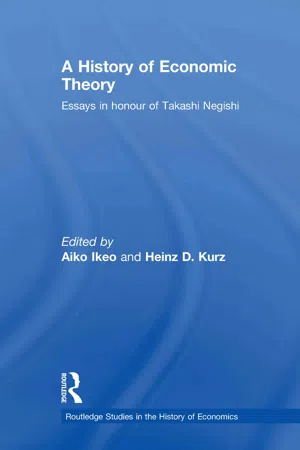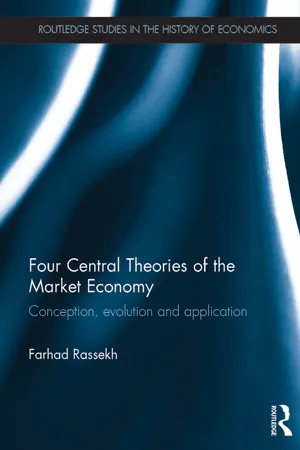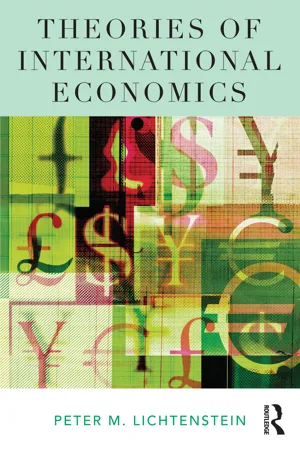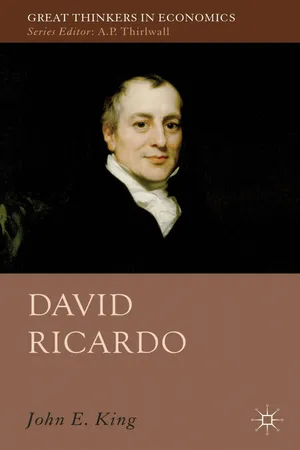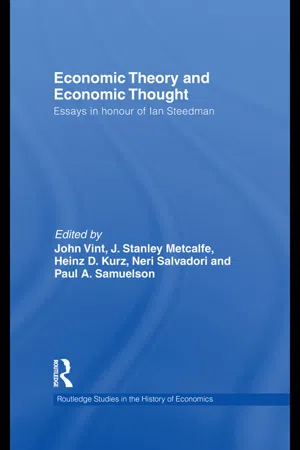Economics
Ricardian Model
The Ricardian model is an economic theory that explains international trade based on comparative advantage. It was developed by David Ricardo in the early 19th century. The model suggests that countries should specialize in producing goods in which they have a comparative advantage and then trade with other countries to maximize overall production and consumption.
Written by Perlego with AI-assistance
Related key terms
Related key terms
1 of 4
Related key terms
1 of 3
9 Key excerpts on "Ricardian Model"
- eBook - ePub
The Science of Economic Development and Growth: The Theory of Factor Proportions
The Theory of Factor Proportions
- C.C. Onyemelukwe(Author)
- 2016(Publication Date)
- Routledge(Publisher)
1 A country is said to have a comparative advantage in producing a good if the opportunity cost of producing that good in terms of other goods is lower in that country than it is in other countries. David Ricardo’s idea of comparative advantage was based on international differences in productivity of labor. So a country was best at producing a good if the labor needed to produce it there was less than anywhere else. Because any economy has limited resources, it is argued that there are limits on what it can produce. The total labor in the economy is said to set the limits of production. In the Ricardian Model, it is claimed that a country will, in a trade-off, produce those things in which the prices are equal to their opportunity cost and the relative prices of goods are equal to their relative labor requirements.There are already problems here. Ricardo did not concern himself with how the goods he was talking about are made. Each of them requires a certain combination of capital, material, and labor to produce. It is obvious that for the unit of goods he has in mind, the one in which the labor proportion is least, will be said to have been produced with less labor and so come out on top in terms of Ricardo’s comparative advantage. It seems that the Ricardian Model is biased toward techniques requiring low labor input techniques. As we have already shown, however, a country’s growth potential is maximized when the factor proportions of all activities are equal to the economy’s factor endowments, and what is required is equal factor proportions for all activities. Whereas in the Ricardian Model, which assumes an economy is unbalanced, labor supply is said to place a limit on the economy’s production, in the new economy we have in mind, labor does not set a limit because the factor proportions, from which production techniques are determined, are based on the economy’s supply of labor.Each economy should have a basic personality of its own, with its growth taking root in this personality. This brings up another issue on which the Ricardian Model (like other trade models we will talk about later) is wrong. It is a static model, and no economy is static. If an economy is growing in the new context, its factor proportions are changing all the time. It is therefore wrong to slot a country’s production pattern into boxes.Samuelson and Nordhaus illustrated the law of comparative advantage by reference to the lawyer who is contemplating whether to hire a typist for the law office or do the typing himself. The question whether or not to hire a typist rested on the law of comparative advantage, and according to Samuelson and Nordhaus, it is apparent that the income the lawyer will forgo by spending the time to do his own typing rather than his legal work is greater than the cost of paying for the typing services. The lawyer makes more money by specializing in the production of legal services, “exporting” these services to others and “importing” typing services. This “free trade” arrangement pays the lawyer and pays the typist. If we assume that the lawyer is absolutely more efficient at typing than the typist (that is, he has an absolute advantage), this still does not mean the lawyer should in fact do the typing. It should be left to the less efficient partner, and this ensures a market for the typist’s services. The typist willingly provides this service; specializing in typing, because alternative uses of the lawyer’s time have less economic value both to the society and to the typist. - eBook - ePub
- Aiko Ikeo, Heinz D. Kurz(Authors)
- 2009(Publication Date)
- Routledge(Publisher)
Samuelson once named the Ricardian theory of comparative advantage as one proposition in all the social sciences that is both true and definitely non-trivial (Samuelson 1969). It is actually one of the few classical tenets that remain to this day. Ricardo’s own explanation of foreign trade is, however, far from articulated. His original exposition on comparative advantage in Chapter 7 ‘On Foreign Trade’ of his The Principles of Political Economy and Taxation (1817) was very concise (Ricardo 1951: Vol. I). It took up only two pages, wherein his ingenious numerical example could be found in Table 6.1. Later, Samuelson referred to this example as the ‘four magic numbers’ (Samuelson 1969: 4). Ricardo never revealed a specific economic model that might exist behind these numbers. This reticence of Ricardo allowed subsequent economists to shape various interpretations from his example. Thus, we now have several trade models that have been associated with Ricardo. Table 6.1 Ricardo’s original example for comparative advantage The most familiar Ricardian trade model is the one that appears in standard textbooks on international trade, such as Caves et al. (2002). This textbook Ricardian trade model is a special case of the neoclassical international trade model called the Heckscher—Ohlin—Samuelson (HOS) model. The neoclassical international trade model usually assumes that there are at least two production factors, e.g. labor and capital. The productions are usually assumed to be under constant returns to scale. The Ricardian Model is a specialized version of this model, in which there exists only one production factor called labor. The term ‘Ricardian’ in this context simply means a linear production function, since a combination of one production factor and constant returns to scale necessarily leads to linear technology. In this framework, Ricardo’s four magic numbers, as shown in Table 6.1, are supposed to represent factor coefficients of both sectors in both countries - eBook - ePub
International Trade
New Patterns of Trade, Production and Investment
- Nigel Grimwade(Author)
- 2020(Publication Date)
- Routledge(Publisher)
Next consider the case or Country B. In this case, the PP line of each country is drawn from the cloth axis to show the relative price of producing cloth in the two countries. Now B's PP line is flatter than A's because B can produce cloth at lower opportunity cost than A, As B specialises in cloth, production shifts from P to P*. P*T is the terms of trade line drawn as starting from P* on the cloth axis. By exchanging 80 units of cloth for 120 units of wheat, B is able to move from P to point C beyond its PP line where it can consume 120 units of cloth and 80 units of wheat. This represents more than it could obtain in the absence of trade as is apparent from the fact that C is beyond B's PP line. Thus, both countries gain from trade. The gain is measured by the movement from a point on a country's PP line to a point beyond it.The Ricardian Model is important for demonstrating the benefits from two countries engaging in trade. First, it demonstrates that the basis for trade between any two countries is the existence of differences in comparative, not absolute, costs. This means that trade is still beneficial even where one country is superior at producing everything providing that its advantage is greatest in at least one activity. Second, providing that the terms of trade lie within the limits set by each country's pre-trade cost ratios, both countries will gain from trade. Thus, trade is not a zero-sum game in which one country gains at the expense of the other. However, the terms of trade will determine how these gains are distributed between countries. Third, the model predicts the pattern of trade that will, in the absence of barriers to trade, take place among different countries. Countries will tend to specialise in those products in which they enjoy low relative costs. These will be the industries in which their labour efficiency is highest relative to that of their trading partner. This provides a reasonably straightforward prediction that can be subject to empirical testing to see how well the theory fits the facts.The Empirical Evidence
Despite the fact that the Ricardian theory of trade was first set out in the early 19th century, it was another 134 years before anyone sought to test the theory to see whether its predictions were borne out in practice. The first formal test was performed by MacDougall in 1951 (MacDougall, 1951). MacDougall sought to determine whether or not the trade of both the United States and the UK with the rest of the world conformed with the predictions of the Ricardian theory. The theory predicts that countries will specialise in those products in which they have a comparative costs advantage. In the Ricardian Model, comparative costs are determined by the relative efficiency of labour. Strictly speaking, the model is applicable only to bilateral trade between two countries. However, bilateral trade between the US and UK was at that time too small relative to each country's total trade and too distorted by tariffs for such an exercise to be usefully performed. Instead, MacDougall focused on each country's trade with the rest of the world. He sought to test the following hypothesis. Since wage rates in manufacturing were roughly twice as high in the US as in Britain, the US should be the dominant exporter in third markets of products in which her labour productivity was more than twice as high as in Britain. Likewise, Britain should be the dominant exporter in products in which U.S. productivity was less than twice as high as in Britain. - eBook - ePub
- Farhad Rassekh(Author)
- 2016(Publication Date)
- Routledge(Publisher)
The Ricardian Model of comparative advantage – built with two countries, two goods, and one factor of production (labor) – is the simplest possible trade model. This raises a question: can this simple model offer insights into the working of international trade in the real world of multi-country, multi-commodity, and multi-factor? As noted above, J. S. Mill's intuition led him to an affirmative answer. But many trade theorists have delved into this question more deeply and their efforts have proven highly fruitful in shedding light on the intricacies of international trade. In fact, the path-dependency of economics in this context is quite palpable as Ricardo's comparative advantage model has spawned numerous theoretical and empirical works. Much of the theoretical research revolves around the generalization of comparative advantage (i.e., whether the Ricardian Model survives under different circumstances) while the empirical investigations generally attempt to determine whether comparative advantage can explain the pattern of international trade.As early as 1835, Mountifort Longfield extended the Ricardian comparative advantage to more than two goods.55 He (1835/1971, p. 70) noted,Let us suppose the productiveness of English labor to be ten times as great as that of any other nation, in the production of tin, calico, coals, cutlery, and pottery. The wages of her laborers will, in consequence, be much greater than those in any other nation; suppose them eight times as great, and suppose that English labor is only twice as productive as foreign labor, in the manufacture of other commodities. These latter, therefore, will be fabricated in the rest of the world, at the fourth part of the price which it will cost to make them in England. - eBook - ePub
- Peter M. Lichtenstein(Author)
- 2016(Publication Date)
- Routledge(Publisher)
Taken as a whole, the contemporary formulation of Ricardian trade theory is a considerable departure from the original aim of Ricardo (and other Classical economists), which was to examine how the international exchange of commodities affects the productive capacities of a nation, its standards of living, and its distribution of income. Rather than solving the above theoretical difficulties, contemporary comparative advantage models ignore these problems altogether by separating the analysis of exchange from the analysis of production. It does this by assuming that the commodities traded do not themselves enter into the production of other tradable and non-tradable commodities. Therefore, the Comparative advantage model disconnects the exchange of commodities from the production of commodities. Computers do not enter into the further production of wheat, and wheat does not enter into the further production of computers. The upshot is that, while there may be gains from trade, it is not clear at all how these gains translate into improved macroeconomic performance.The Ricardian pure exchange theory of trade leaves us with the naively simple and unproblematic proposition that, if two nations exchange something, they will only do so if they benefit from the exchange; thus, if the exchange takes place, they will both benefit. This approach sheds very little light on the real world economy.What can we conclude, then, about the Ricardian principle of comparative advantage and its corollaries of free trade and specialization? The inescapable conclusion is that, despite the overwhelming conviction that the principle is a universal truth, it is in fact theoretically narrow in scope, empirically unreliable, and limited in practical application.Conclusions
Classical economics incorporated international trade theory into a broader, general theory of capitalism. The concerns of Classical economists, were with a rapidly growing, expanding economic system that, by the time of Smith and Ricardo, stretched far and wide. Indeed, very little of the globe remained unaffected by the reach of European capitalism and European civilization. What did this global expansion mean for the welfare of European nations and for their prospects for continued growth and development? Would the economies of Europe continue to grow, or would they succumb to built-in forces that brought the capitalist engine to a halt? - eBook - ePub
- J. King(Author)
- 2013(Publication Date)
- Palgrave Macmillan(Publisher)
Probably the most important relevant criticism concerns the supposedly static nature of Ricardo’s trade theory, which, according to Harry Johnson, assumes ‘a static and permanent distribution of comparative advantages and disadvantages’, so that comparative advantage is ‘ineluctably fixed by nature’ (cited by Bloomfield 1994, p. 24). As early as 1929 John Williams had objected that ‘classical theory assumes as fixed, for purposes of the reasoning, the very things which, in my view, should be the chief objects of study if what we wish to know is the effects and causes of international trade’, above all ‘the development of new resources and productive forces’ (Williams 1929, p. 196).Ricardo is sometimes compared unfavourably with Adam Smith in this regard. Thus Andrea Maneschi cites Paul Krugman on ‘the long dominance of Ricardo over Smith – of comparative advantage over increasing returns’, due largely to the greater mathematical tractability of the former. Maneschi himself notes that Smith had stressed the ‘feedback process’ between trade and productivity growth, and for that reason is now seen as a precursor of ‘new trade theory’ (Maneschi 1998, p. 214, citing Krugman 1990, p. 4).In similar vein, James Buchanan and Yong J. Yoon describe Smith and Ricardo as providing ‘two categorically different logical arguments’ on trade. For Smith, specialization is productive, even if the individuals who specialize and then trade with each other do not differ at all in their productive abilities. ‘By contrast, the Ricardian logic locates the origin of exchange in the differences among persons … In the Smithian setting, exchange emerges because of the advantages of specialization; in the Ricardian setting, specialization and subsequent trade become advantageous because of inherent differences among potential trading parties’. In reality trade ‘is explained by some combination of the two elements’, but ‘neoclassical economics tends to assign almost exclusive weight to the Ricardian explanation’ (Buchanan and Yoon 2002, pp. 2–4).There is one important political implication: while in the Smithian view everyone gains from trade, and there are no net losers, this need not be so in the Ricardian conception. ‘In their role as consumers, all persons will secure gains, but those gains may be overwhelmed by losses as producers for the groups threatened by imports’ (ibid - eBook - ePub
Global Trade Policy
Questions and Answers
- Pamela J. Smith(Author)
- 2013(Publication Date)
- Wiley-Blackwell(Publisher)
The model also tells us about the distribution of gains from trade within countries. Specifically, the mobile factor (such as labor) gains in terms of its nominal wage rate. However, in real terms, the mobile factor loses in terms of its purchasing power of the good that the country exports, and gains in terms of its purchasing power of the good that the country imports. The model also shows gains and losses in the rental rates paid to the specific immobile factors (such as capital and land). That is, those that gain from trade are the owners of a country's abundant immobile factors. Those that lose from trade are the owners of a country's scarce immobile factors.These results of the SF model are short-run results. The short run corresponds with the time period when some factors of production cannot be easily moved into use in other industries.2.4 Summary Remarks
This chapter explored inter-industry, inter-firm trade. This trade is two-way trade in dissimilar goods between the national firms of countries. We examined this trade using three traditional trade models: the Ricardian Model, the Heckscher-Ohlin model, and the Specific Factors model. These three models are grounded on the concept of comparative advantage. The law of comparative advantage says that countries will produce and export goods that have a lower relative cost, and therefore price, in autarky. In the Ricardian Model, this comparative advantage arises from differences in technologies across countries. In the Heckscher-Ohlin model, comparative advantage arises from differences in endowments across countries. And, in the Specific Factors model, comparative advantage arises from differences in immobile endowments across countries. The Ricardian and Heckscher-Ohlin models are long-term models because they allow factors of production to move freely across industries. The Specific Factors model is a short-term model because it accounts for the immobility of factors of production across industries. Below, we summarize the key findings from each of these models.What are the effects of trade in the long run, when countries differ in technologies? - eBook - ePub
Ricardo's Theory of Growth and Accumulation
A Modern View
- Neri Salvadori(Author)
- 2020(Publication Date)
- Routledge(Publisher)
a larger rate of profits for each wage rate). This is what is called the (static) gain from trade. It is remarkable that the gain in question is likewise obtained by a country that has an absolute advantage in the production of all commodities, and that even a country which has an absolute disadvantage in the production of all commodities may trade and get a gain from it. Ricardo was conscious of the fact that specialization is not related to absolute advantages, but to comparative advantages. He gave a simple example in which two countries, England and Portugal, can produce two commodities: cloth and wine. England exports cloth to Portugal and imports wine, and Portugal exports wine and imports cloth (Works I: 134–135). Such a situation happens despite the fact that Portugal has lower real costs in the production of both commodities. Ricardo showed that this exchange comes about because each country has a greater relative facility of production in one commodity: wine is relatively less expensive to produce than cloth in Portugal, and cloth relatively less expensive to produce than wine in England. Although only ten paragraphs in Chapter 7 of Ricardo’s Principles concern what are called comparative advantages, standard textbook presentations of the Ricardian theory of international trade place great emphasis on the issue of comparative advantages, which was extensively used by neoclassical economists in their analyses of international trade. It is worth mentioning an episode Samuelson recalled in his Presidential Address to the International Economic Association in 1969, which expresses how much he admired Ricardo and his discovery of comparative advantages. Samuelson and the mathematician Stanislaw Ulam were both members of the Society of Fellows at Harvard (before 1940, when Samuelson become Assistant Professor at MIT), and Ulam used to tease Samuelson by saying “Name one proposition in all of the social sciences which is both true and nontrivial” - eBook - ePub
Economic Theory and Economic Thought
Essays in Honour of Ian Steedman
- John Vint, J. Stanley Metcalfe, Heinz D. Kurz, Neri Salvadori, Paul Samuelson(Authors)
- 2010(Publication Date)
- Routledge(Publisher)
If the opening to trade leads to positive quantities of trade, each country exports that commodity in which it has a comparative labour-productivity advantage” (1998, p. 33, emphasis added).9 In the rest of this work we prefer the expression “time-phased” instead of “Neo-Ricardian”, because our argument, focused on absolute instead of comparative advantage, implies a substantial departure from the Ricardian principle of international trade and would make inappropriate the alternative denomination.10 Bhagwati et al. (1998) acknowledge that, if excess demand functions are used to close the Ricardian Model and give rise to multiple equilibria, the opening of trade may not lead to positive quantities of trade, and they suggest additional restrictions that exclude this possibility.11 Metcalfe and Steedman (1979) present a time-phased model in which financial capital is assumed to be mobile across countries, whereas foreign direct investment is excluded. 12 In particular, the supply of labour in each trading economy may be assumed to be elastic at the going wage, as in the classical theory of wages and population. 13 However, the equilibrium of a small open country with a wage rate higher than the minimum self-sufficiency wage rate implicitly presupposes an amount of labour in short supply. 14 This notion was resumed by Kindelberger (1978) with reference to the theory of international trade and reconsidered in Parrinello (2002). 15 See Clarida and Findlay (1991).16 This applies in particular to the representation of the technology by means of production functions. In this case Sj should be included as a variable together with the productive inputs.17 Although a reswitch of non-competitiveness is possible as the wage rate changes, there will exist a sufficiently high wage rate, such that from that level onward the economy becomes and remains uncompetitive. For this reason we use the expression “ultimate” border line of competitiveness.
Index pages curate the most relevant extracts from our library of academic textbooks. They’ve been created using an in-house natural language model (NLM), each adding context and meaning to key research topics.
Explore more topic indexes
Explore more topic indexes
1 of 6
Explore more topic indexes
1 of 4
